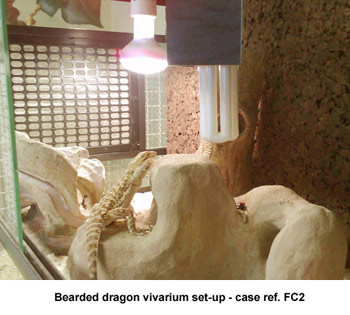|
|
This
is one case from a series of reports compiled as part
of an investigation into photo-kerato-conjunctivitis,
possibly occurring as a result of excessive low-wavelength
UVB radiation under certain brands of fluorescent
UVB lamp.
Please
do not view this one case without reference to the
whole report of which it is a part.
|
Case
History : FC2
(Italy) - Bearded dragon juveniles
(Pogona vitticeps)
Cases
examined by Michele Buono DVM (Turin, Italy)
 Two
juvenile red-phase bearded dragons (Pogona vitticeps),
purchased in June 2007, had been placed in a new glass terrarium,
size 100cm by 60cm by 60cm. (39in by 24in by 24in.) The
substrate was ZooMed ReptiSand. Two
juvenile red-phase bearded dragons (Pogona vitticeps),
purchased in June 2007, had been placed in a new glass terrarium,
size 100cm by 60cm by 60cm. (39in by 24in by 24in.) The
substrate was ZooMed ReptiSand.
A
large basking rock was placed between a basking spot lamp
and a new ZooMed Reptisun 10.0 Compact Lamp in a reflector
fixture. The rock was very close to the fixture, so the
distance from the basking spot to the lamp was less than
15cm. (6 in.) (Figure 1.)
The
animals were presented to the veterinary clinic after 7
days, as they had become anorexic, inactive, and kept their
eyes closed.
At
clinical examination the only symptom was closure of the
eyes, with a light swelling of the lower eyelids. No therapy
was suggested except the replacement of the lamp with a
ZooMed Reptisun 5.0 Compact Lamp and moving and lowering
the basking spot to a distance of 30cm from the compact
lamp.
After
5 days the eyelid swelling had disappeared and after 10
days the animals were active and eating again.
|


















 Two
juvenile red-phase bearded dragons (Pogona vitticeps),
purchased in June 2007, had been placed in a new glass terrarium,
size 100cm by 60cm by 60cm. (39in by 24in by 24in.) The
substrate was ZooMed ReptiSand.
Two
juvenile red-phase bearded dragons (Pogona vitticeps),
purchased in June 2007, had been placed in a new glass terrarium,
size 100cm by 60cm by 60cm. (39in by 24in by 24in.) The
substrate was ZooMed ReptiSand.